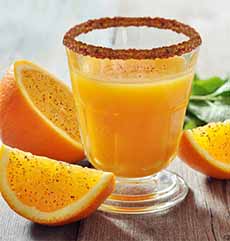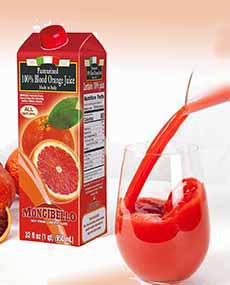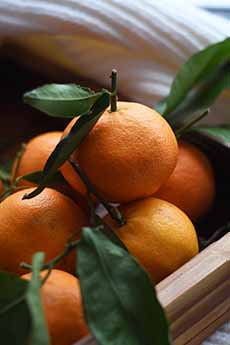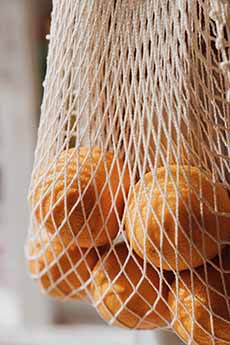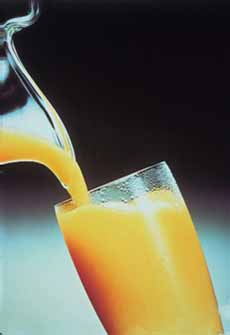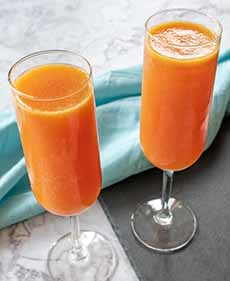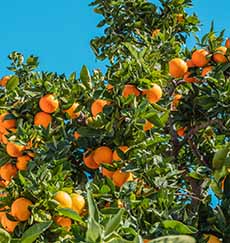National Orange Juice Day & The History Of Oranges
|
|
May 4th is National Orange Juice Day, a holiday sponsored by the Florida Department of Citrus. Florida processes more orange juice than any other state (much of it becomes frozen juice concentrate). Florida’s crops are mostly juice oranges, while California produces the majority of table oranges as well as orange varieties for juicing. Brazil is the leading global orange juice producer by far, with a production volume of more than three times the second-place producer*, the U.S. Start by checking out our 10 Uses For Orange Juice, beyond drinking a glass of it. We’re starting our celebration with: Lemons, oranges, limes, grapefruit, tangerines, and pomelos are just a few of the juicy citrus fruits grown in Florida. Citrus contains the anti-carcinogen antioxidants known as flavonoids. Citrus also is packed with fiber and vitamin C, and lesser amounts of calcium, potassium, and vitamin A. There are three types of oranges: sweet oranges (Citrus x sinensis), bitter oranges (Citrus x aurantium), and mandarins (Citrus reticulata)—here’s the difference between mandarins and oranges. Oranges are members of the Rutaceae family, which includes the citrus genus and many species within the genus (grapefruits, lemons, limes, oranges, pomelos, etc.). There are some 1,600 subspecies. The oranges we mostly consume are sweet oranges (bitter oranges are used for marmalade and some other culinary purposes). The sweet orange is a hybrid between the pomelo (Citrus maxima) and the mandarin. Sweet oranges are about 70% of the global citrus industry. Wild oranges originated in the region that is now southern China and northern India. They have been cultivated for at least 7,000 years in India, and in China for some 4,500 years. They were bitter and originally used for medicinal purposes, with sweet varieties developed after centuries of breeding. It is believed that traders from the Persian Empire brought oranges from India and Sri Lanka to the Roman Empire, as early as 100 B.C.E. Oranges then spread by multinational trading ships and caravans. By the 11th century, using seeds of Persian oranges, Spain and Morocco began to produce improved orange varieties. One well-known variety is the Seville orange from Spain, a bitter orange used for marmalade and liqueurs. Soon, oranges were grown on Cananeia, an island off São Paulo in Brazil. The orange became a popular and healthy† fruit globally. Today, oranges are the fifth most-purchased fruit in the U.S., following bananas, apples, strawberries, and grapes [source]. Prior to 1920, the orange was mainly served as a dessert fruit. The per-capita consumption increased with: Prior to World War II, most Americans drank canned orange juice. During World War II, the federal government and the Florida Department of Citrus worked with a group of scientists to develop a superior-tasting product. The result, frozen concentrated orange juice, was introduced in 1948. A small tube, easy to store in the freezer, was mixed at home with water. The juice was affordable, tasty, convenient, and high in vitamin C. By the 1980s, food scientists had developed a fresher-tasting refrigerated juice known as reconstituted ready-to-serve juice. The next improvement, in the 1990s, “not from concentrate” (NFC) refrigerated juice, remains the standard today. |
|
|
ORANGE TRIVIA Before the late 15th century, the color we know as orange existed in Europe, but without the name. It was simply called yellow-red. Portuguese merchants brought the first orange trees to Europe from Asia in the late 15th and early 16th centuries. They introduced them by their Sanskrit name, naranga. Naranga became naranja in Spanish, laranja in Portuguese, arancia in Italian, and orange in English, French, and German. ________________ *A study of the leading orange juice-producing countries worldwide in 2019/2020, from Statista. †The health value of orange juice is debatable. It has a high concentration of vitamin C, but also a very high concentration of simple sugars, comparable to soft drinks. As a result, some nutritional advice encourages the substitution of orange juice with raw fruit, which is a lower-glycemic option [source]. |
||
